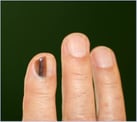Acral melanoma: Everything you need to know
Acral lentiginous melanoma is a type of skin cancer making up about one to three per cent of melanomas. It is unique because it occurs on the hands and feet, including the palms, soles, fingers, toes, and even underneath the nails.
Did you know? Bob Marley died from a melanoma on the bottom of his toe.
What causes acral melanoma?
Unlike most other skin cancers, acral melanoma is not caused by UV radiation. It appears in areas that aren’t necessarily exposed to the sun. Trauma, environmental factors, and a family history of melanoma may all cause acral melanoma to develop.
What does acral melanoma look like?
Acral melanoma can sometimes resemble a patch of discoloured skin. If left untreated, melanoma can spread to other organs and become deadly within months or years.


Images: https://dermnetnz.org
Who is at risk of acral melanoma?
Both men and women are at risk of acral melanoma, and the risk increases as you get older. The average age of patients with acral melanoma is 63 years, but melanoma can develop on anyone of any age. In fact, it is the most common cancer in young Australians aged 15 to 39.
Did you know? Acral melanoma is the most common cancer among people with darker skin in the USA, and the most common type of melanoma in Mexico, China and Taiwan.
How is acral melanoma treated?
Treatment for all types of skin cancer depends on the size, depth and location of the lesion, as well as how advanced it is. Acral melanoma is usually surgically removed. In extreme cases, part or all of a finger or toe will be amputated to remove the acral melanoma.
What is the survival rate of acral melanoma?
When detected early, 99 per cent of skin cancers can be successfully treated. Unfortunately, acral melanoma can be easy to miss because of its location on the body, which can delay a diagnosis and treatment. This may be why its survival rate is lower compared to other types of melanoma, and why regular skin cancer checks are so important.
- Tags:
- melanoma
